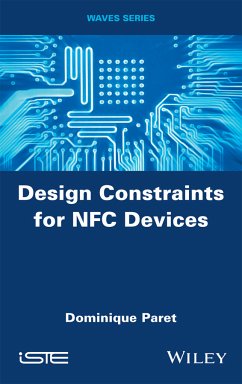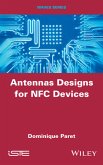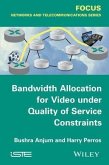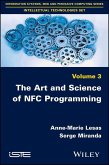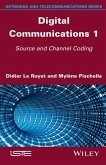Design Constraints for NFC Devices (eBook, PDF)


Alle Infos zum eBook verschenken

Design Constraints for NFC Devices (eBook, PDF)
- Format: PDF
- Merkliste
- Auf die Merkliste
- Bewerten Bewerten
- Teilen
- Produkt teilen
- Produkterinnerung
- Produkterinnerung

Hier können Sie sich einloggen

Bitte loggen Sie sich zunächst in Ihr Kundenkonto ein oder registrieren Sie sich bei bücher.de, um das eBook-Abo tolino select nutzen zu können.
Near field communication (NFC) can appear to be a simple intuitive technology for exchanging data between close devices. In reality, these contactless structures that combine components and antennas must respect important and specific working constraints. Illustrated by a number of detailed technological examples, this book discusses the multiple normative (ISO, CEN, NFC Forum, EMVCo, etc.) and regulatory (ERC, FCC, ETSI, radiofrequency, private and ecological pollution, etc.) constraints, as well as the applied, typological, functional, structural, environmental or interoperability…mehr
- Geräte: PC
- mit Kopierschutz
- eBook Hilfe
- Größe: 17MB
![Antenna Designs for NFC Devices (eBook, PDF) Antenna Designs for NFC Devices (eBook, PDF)]() Dominique ParetAntenna Designs for NFC Devices (eBook, PDF)139,99 €
Dominique ParetAntenna Designs for NFC Devices (eBook, PDF)139,99 €![Bandwidth Allocation for Video under Quality of Service Constraints (eBook, PDF) Bandwidth Allocation for Video under Quality of Service Constraints (eBook, PDF)]() Bushra AnjumBandwidth Allocation for Video under Quality of Service Constraints (eBook, PDF)139,99 €
Bushra AnjumBandwidth Allocation for Video under Quality of Service Constraints (eBook, PDF)139,99 €![Near Field Communication (NFC) (eBook, PDF) Near Field Communication (NFC) (eBook, PDF)]() Vedat CoskunNear Field Communication (NFC) (eBook, PDF)91,99 €
Vedat CoskunNear Field Communication (NFC) (eBook, PDF)91,99 €![Modeling and Design of Secure Internet of Things (eBook, PDF) Modeling and Design of Secure Internet of Things (eBook, PDF)]() Modeling and Design of Secure Internet of Things (eBook, PDF)125,99 €
Modeling and Design of Secure Internet of Things (eBook, PDF)125,99 €![Digital Radio System Design (eBook, PDF) Digital Radio System Design (eBook, PDF)]() Grigorios KalivasDigital Radio System Design (eBook, PDF)88,99 €
Grigorios KalivasDigital Radio System Design (eBook, PDF)88,99 €![The Art and Science of NFC Programming (eBook, PDF) The Art and Science of NFC Programming (eBook, PDF)]() Anne-Marie LesasThe Art and Science of NFC Programming (eBook, PDF)139,99 €
Anne-Marie LesasThe Art and Science of NFC Programming (eBook, PDF)139,99 €![Digital Communications 1 (eBook, PDF) Digital Communications 1 (eBook, PDF)]() Didier Le RuyetDigital Communications 1 (eBook, PDF)139,99 €
Didier Le RuyetDigital Communications 1 (eBook, PDF)139,99 €-
-
-
Dieser Download kann aus rechtlichen Gründen nur mit Rechnungsadresse in A, B, BG, CY, CZ, D, DK, EW, E, FIN, F, GR, HR, H, IRL, I, LT, L, LR, M, NL, PL, P, R, S, SLO, SK ausgeliefert werden.
- Produktdetails
- Verlag: John Wiley & Sons
- Seitenzahl: 224
- Erscheinungstermin: 1. April 2016
- Englisch
- ISBN-13: 9781119292203
- Artikelnr.: 44872693
- Verlag: John Wiley & Sons
- Seitenzahl: 224
- Erscheinungstermin: 1. April 2016
- Englisch
- ISBN-13: 9781119292203
- Artikelnr.: 44872693
- Herstellerkennzeichnung Die Herstellerinformationen sind derzeit nicht verfügbar.
/2
(Fraunhofer zone) 6 1.1.5. Intermediary field: r approximately equal to
(Fresnel zone) 7 1.1.6. Near field: r <<
/2
(Rayleigh zone) and the origin of NFC 7 1.1.7. Remarks on contactless, RFID and NFC applications 7 1.2. The concept of NFC 9 1.2.1. Biot-Savart law 10 1.2.2. Field H at a point on the axis of a circular antenna 10 1.2.3. Decrease in the field H as a function of "d" 13 1.2.4. Field H at a point on the axis of a rectangular antenna 14 Chapter 2. Normative Constraints of NFC 17 2.1. Introduction 17 2.1.1. Normative, regulatory and NFC market constraints 17 2.1.2. A little bit of vocabulary 18 2.1.3. Norm 19 2.1.4. Standard 19 2.2. Normative constraints 19 2.2.1. Uplink from initiator to targets 20 2.2.2. "Contactless" normative constraints on NFC device antennae 27 2.3. Conclusion 36 Chapter 3. Regulatory Constraints and Recommendations 39 3.1. Regulatory constraints specific to NFC and NFC antennas 39 3.1.1. State of RF regulations 39 3.1.2. Constraints pertaining to radiation and pollution by NFC 41 3.1.3. The ERC 70 03 recommendation and the ETSI 300 330 norm 41 3.2. Constraints due to recommendations 45 3.2.1. Exposure of the human body to EM fields 46 3.2.2. Societal constraints due to individual freedoms (privacy) 48 3.2.3. Environmental constraints 50 3.3. Constraints of the NFC market 52 3.3.1. NFC applications of short range devices 52 3.3.2. Costs and market prices desired by users 52 3.3.3. Beware of false advertising 53 Part 2. Constraints Due to the Field of Applications of NFC 55 Introduction to Part 2 57 Chapter 4. Applicational Typologies of the NFC and their Consequences 59 4.1. Applicational typologies of the NFC 59 4.1.1. Technologies 59 4.1.2. "NFC Forum Devices" and "NFC Forum Tags" 60 4.1.3. "Modes" of communication of an NFC Forum Device 62 4.1.4. Role of an NFC Forum Device 63 4.1.5. Applicational typological possibilities and their constraints 64 4.2. Application consequences and their direct constraints 67 4.2.1. Touch & Go typology 67 4.2.2. Touch & Confirm typology 67 4.2.3. Touch & Connect typology 67 4.2.4. Touch & Explore typology 68 Chapter 5. Constraints Due to Fields of Application 69 5.1. Range of technical possibilities of applications 69 5.1.1. In architectures and electronic functions 69 5.1.2. Shapes, dimensions and form factors (publicity aside) 70 5.1.3. Remarks and some clarifications about the table 70 5.1.4. Targets/tags for the monitoring of long-distance races 72 5.1.5. Targets/tags for monitoring luxury items 72 5.2. Segmentation, typologies of markets, their problems and their incidences, and direct technical constraints on NFC devices 73 5.2.1. Market sectors and typologies 74 5.3. Mobile telephony 75 5.4. Banks/money matters/payments 77 5.5. Transport 78 5.5.1. 1st case: card emulation mode in battery-assisted and then flat battery 81 5.5.2. 2nd case: card emulation mode with battery out 81 5.5.3. 3rd case: collisions and loading effects 82 5.6. Automobiles 82 5.6.1. Consumer electronics 85 5.7. Healthcare 88 5.8. Communicating objects 89 5.8.1. NFC tablets 89 5.8.2. NFC USB key 90 5.8.3. NFC communication and promotional objects 91 5.8.4. "Add-on" NFC devices, sticks, and stickers 92 Part 3. Applicational Constraints Needing to be Solved when Designing NFC Systems and their Antennas 95 Introduction to Part 3 97 Chapter 6. Structural Constraints in NFC 99 6.1. Constraints due to the form factors of the antennas 99 6.2. Constraints due to variations of the operating distance 100 6.2.1. Distances and magnetic couplings 100 6.3. Constraint of the maximum acceptable value of the quality coefficient Q of the initiator antenna 100 6.4. Constraint of the value of return (retro) modulation voltage 102 6.4.1. Passive Load Modulation (PLM) 103 6.4.2. Active Load Modulation (ALM) 106 Chapter 7. Functional Applicational Constraints 111 7.1. Antenna tuning/detuning constraints 111 7.1.1. The case of an initiator 111 7.1.2. Electrical representation of the target 112 7.1.3. "Tuned", "untuned" and "detuned" mobile phones 120 7.2. Constraints and influences of the environment 124 7.2.1. Physical influence of the environment 124 7.2.2. Impacts of the environment on the antenna and its performance 124 7.2.3. Electrical fields E 125 7.2.4. Magnetic field 128 Part 4. Conformity and Interoperability Constraints 137 Introduction to Part 4 139 Chapter 8. Conformity Constraints 141 8.1. Conformity tests for NFC devices 141 8.2. Norms of "conformity" tests for NFC IPx 142 8.2.1. ISO 23917 tests (NFC IP1 protocol) 143 8.2.2. ISO 22536 tests (NFC IP1 RF interface) 143 8.3. Electrical characterizations of the initiator antenna 146 8.3.1. The antenna's inductance and resistance 146 8.3.2. Quality coefficient 149 8.3.3. Bandwidth 149 8.3.4. Tuning of the antenna and its impedance matching 149 8.4. Method of adjustment of the target antenna 154 8.4.1. Absorption threshold, H_thr 154 8.4.2. Absorption in reading mode, H_read 154 8.4.3. Resonance frequency, f_res 154 8.4.4. Bandwidth 155 8.5. Measuring methods for use with the target 155 8.6. Electrical measurements of the initiator antenna 156 8.6.1. Measuring the magnetic field H radiated by the initiator 156 8.6.2. Measurement of the quality coefficient - Q 158 8.6.3. Measuring Q in the application 162 8.6.4. Measuring the bandwidth in the application 163 8.7. Method for adjustment of whole systems 165 8.7.1. Measurements needing to be performed 165 8.7.2. Order in which the measurements must be taken 165 8.7.3. Energy domains, zero lines, and safe operating areas 165 8.8. Measuring tools 166 Chapter 9. Interoperability Constraints 169 9.1. Norms and interoperability 169 9.2. Problems of the tests; JNCF ISO vs EMV vs NFC Forum; etc 170 9.2.1. EMV conformity tests . 171 9.3. In practice: a few simple examples of measurements 178 9.3.1. Example 1 179 9.3.2. Example 2 181 9.3.3. Conformity tests of the NFC Forum 185 9.3.4. NFC Forum testing and certification methods for the lower levels 186 9.3.5. Testing the conformity of NFC with the CEN - Comité européen de normalisation (European Standardizing Committee) 187 9.3.6. What about overall interoperability? 188 Conclusion 189 Bibliography 197 Index 199
/2
(Fraunhofer zone) 6 1.1.5. Intermediary field: r approximately equal to
(Fresnel zone) 7 1.1.6. Near field: r <<
/2
(Rayleigh zone) and the origin of NFC 7 1.1.7. Remarks on contactless, RFID and NFC applications 7 1.2. The concept of NFC 9 1.2.1. Biot-Savart law 10 1.2.2. Field H at a point on the axis of a circular antenna 10 1.2.3. Decrease in the field H as a function of "d" 13 1.2.4. Field H at a point on the axis of a rectangular antenna 14 Chapter 2. Normative Constraints of NFC 17 2.1. Introduction 17 2.1.1. Normative, regulatory and NFC market constraints 17 2.1.2. A little bit of vocabulary 18 2.1.3. Norm 19 2.1.4. Standard 19 2.2. Normative constraints 19 2.2.1. Uplink from initiator to targets 20 2.2.2. "Contactless" normative constraints on NFC device antennae 27 2.3. Conclusion 36 Chapter 3. Regulatory Constraints and Recommendations 39 3.1. Regulatory constraints specific to NFC and NFC antennas 39 3.1.1. State of RF regulations 39 3.1.2. Constraints pertaining to radiation and pollution by NFC 41 3.1.3. The ERC 70 03 recommendation and the ETSI 300 330 norm 41 3.2. Constraints due to recommendations 45 3.2.1. Exposure of the human body to EM fields 46 3.2.2. Societal constraints due to individual freedoms (privacy) 48 3.2.3. Environmental constraints 50 3.3. Constraints of the NFC market 52 3.3.1. NFC applications of short range devices 52 3.3.2. Costs and market prices desired by users 52 3.3.3. Beware of false advertising 53 Part 2. Constraints Due to the Field of Applications of NFC 55 Introduction to Part 2 57 Chapter 4. Applicational Typologies of the NFC and their Consequences 59 4.1. Applicational typologies of the NFC 59 4.1.1. Technologies 59 4.1.2. "NFC Forum Devices" and "NFC Forum Tags" 60 4.1.3. "Modes" of communication of an NFC Forum Device 62 4.1.4. Role of an NFC Forum Device 63 4.1.5. Applicational typological possibilities and their constraints 64 4.2. Application consequences and their direct constraints 67 4.2.1. Touch & Go typology 67 4.2.2. Touch & Confirm typology 67 4.2.3. Touch & Connect typology 67 4.2.4. Touch & Explore typology 68 Chapter 5. Constraints Due to Fields of Application 69 5.1. Range of technical possibilities of applications 69 5.1.1. In architectures and electronic functions 69 5.1.2. Shapes, dimensions and form factors (publicity aside) 70 5.1.3. Remarks and some clarifications about the table 70 5.1.4. Targets/tags for the monitoring of long-distance races 72 5.1.5. Targets/tags for monitoring luxury items 72 5.2. Segmentation, typologies of markets, their problems and their incidences, and direct technical constraints on NFC devices 73 5.2.1. Market sectors and typologies 74 5.3. Mobile telephony 75 5.4. Banks/money matters/payments 77 5.5. Transport 78 5.5.1. 1st case: card emulation mode in battery-assisted and then flat battery 81 5.5.2. 2nd case: card emulation mode with battery out 81 5.5.3. 3rd case: collisions and loading effects 82 5.6. Automobiles 82 5.6.1. Consumer electronics 85 5.7. Healthcare 88 5.8. Communicating objects 89 5.8.1. NFC tablets 89 5.8.2. NFC USB key 90 5.8.3. NFC communication and promotional objects 91 5.8.4. "Add-on" NFC devices, sticks, and stickers 92 Part 3. Applicational Constraints Needing to be Solved when Designing NFC Systems and their Antennas 95 Introduction to Part 3 97 Chapter 6. Structural Constraints in NFC 99 6.1. Constraints due to the form factors of the antennas 99 6.2. Constraints due to variations of the operating distance 100 6.2.1. Distances and magnetic couplings 100 6.3. Constraint of the maximum acceptable value of the quality coefficient Q of the initiator antenna 100 6.4. Constraint of the value of return (retro) modulation voltage 102 6.4.1. Passive Load Modulation (PLM) 103 6.4.2. Active Load Modulation (ALM) 106 Chapter 7. Functional Applicational Constraints 111 7.1. Antenna tuning/detuning constraints 111 7.1.1. The case of an initiator 111 7.1.2. Electrical representation of the target 112 7.1.3. "Tuned", "untuned" and "detuned" mobile phones 120 7.2. Constraints and influences of the environment 124 7.2.1. Physical influence of the environment 124 7.2.2. Impacts of the environment on the antenna and its performance 124 7.2.3. Electrical fields E 125 7.2.4. Magnetic field 128 Part 4. Conformity and Interoperability Constraints 137 Introduction to Part 4 139 Chapter 8. Conformity Constraints 141 8.1. Conformity tests for NFC devices 141 8.2. Norms of "conformity" tests for NFC IPx 142 8.2.1. ISO 23917 tests (NFC IP1 protocol) 143 8.2.2. ISO 22536 tests (NFC IP1 RF interface) 143 8.3. Electrical characterizations of the initiator antenna 146 8.3.1. The antenna's inductance and resistance 146 8.3.2. Quality coefficient 149 8.3.3. Bandwidth 149 8.3.4. Tuning of the antenna and its impedance matching 149 8.4. Method of adjustment of the target antenna 154 8.4.1. Absorption threshold, H_thr 154 8.4.2. Absorption in reading mode, H_read 154 8.4.3. Resonance frequency, f_res 154 8.4.4. Bandwidth 155 8.5. Measuring methods for use with the target 155 8.6. Electrical measurements of the initiator antenna 156 8.6.1. Measuring the magnetic field H radiated by the initiator 156 8.6.2. Measurement of the quality coefficient - Q 158 8.6.3. Measuring Q in the application 162 8.6.4. Measuring the bandwidth in the application 163 8.7. Method for adjustment of whole systems 165 8.7.1. Measurements needing to be performed 165 8.7.2. Order in which the measurements must be taken 165 8.7.3. Energy domains, zero lines, and safe operating areas 165 8.8. Measuring tools 166 Chapter 9. Interoperability Constraints 169 9.1. Norms and interoperability 169 9.2. Problems of the tests; JNCF ISO vs EMV vs NFC Forum; etc 170 9.2.1. EMV conformity tests . 171 9.3. In practice: a few simple examples of measurements 178 9.3.1. Example 1 179 9.3.2. Example 2 181 9.3.3. Conformity tests of the NFC Forum 185 9.3.4. NFC Forum testing and certification methods for the lower levels 186 9.3.5. Testing the conformity of NFC with the CEN - Comité européen de normalisation (European Standardizing Committee) 187 9.3.6. What about overall interoperability? 188 Conclusion 189 Bibliography 197 Index 199
